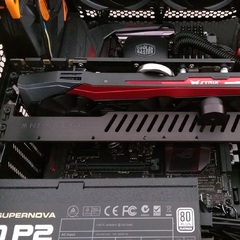-
Posts
94 -
Joined
-
Last visited
Profile Information
-
Gender
Male
-
Occupation
Design Engineer (CAD)
-
Member title
Junior Member
System
-
CPU
Intel; Core i7-6700K
-
Motherboard
Asus; Maximus VIII Hero
-
RAM
Corsair; Corsair Vengeance LPX 32GB (4x 8GB)
-
GPU
PNY; Quadro RTX5000
-
Case
Fractal Design; Define R5 Blackout Edition
-
Storage
1x Samsung; 970 Evo Plus 1TB, 2x Samsung; 860 Pro SSD 512GB, 2x Western Digital; Red Pro 2TB, 2x Western Digital; Red Pro 4TB (RAID 1)
-
PSU
EVGA; Supernova 1000 P2
-
Display(s)
1x Asus; ROG Swift PG348Q (3440x1440 @100Hz), 1x LG; 27GP850-B (2560x1440 @100Hz)
-
Cooling
Noctua NHD15 (LTT edition)
-
Keyboard
WASD; Code 104 Key c/w Cherry MX Greens
-
Mouse
Cyborg; R.A.T. 7
-
Sound
HyperX; Cloud
-
Operating System
Microsoft; Windows 10
Recent Profile Visitors
1,428 profile views
xXDeltaXx's Achievements
-
I'm going to be having the Solidworks guy come out and do a 'supported' install of the PDM environment - so that means I can have the full support structure as I go. . . from that point of view, my current Windows Server setup has the main OS drive and a dedicated pair of 2tb HDDs for the actual PDM vault. I'd like to replicate that as closely as possible as I know it works. The 2x 1TB NVME drives with Proxmox and the Server VM (100GB at present) will be great for the OS, so it's just creating that 'D-drive' From your suggestion I think it is sounding like setting all 8x 2TB NVMEs drives up to all pass through to TrueNAS and then look at setting up 2TB of that via iSCSI for the Drive is the way to go. Thanks
- 8 replies
-
- proxmox
- truenas scale
-
(and 1 more)
Tagged with:
-
That's kind of where the learning / noob aspect comes into it. I know the general end result, but the way to get there is based off the best knowledge I have at that point in time. I've got 2x1TB NVME drives to use as the main Prox mox / VM drives. I've got an additional 8x 2TB NVME drives to have as fast storage for the Windows Server storage (2TB to match my current setup), and the rest to use as fast storage for TrueNAS/Plex/whatever gets added as I continue to build out. There will be a few HDDs added either via an HBA or the motherboard SATA ports - just for mass storage and backups. P1 is to replace my current Windows Server 2016 build with a Windows Server 2022 VM. This will be used for Solidworks PDM, with that Active Directory, and possibly some other Windows bits and bobs. (This then frees up that box to be rebuild as a backup server to back up the new one. P2 is to add better network storage and proper back ups for my connected PCs / Laptops. P3 is to add other features like Plex, maybe a Steam cache... once the main fucntions are there, then I can start looking around at other fun things / things to learn.
- 8 replies
-
- proxmox
- truenas scale
-
(and 1 more)
Tagged with:
-
As I understood it / understand it, Proxmox is the 'better' hypervisor and TrueNAS Scale is 'better' for storage... hence using both. The logic for passing through the first set of drives to TrueNAS was based on initially creating the ZFS in proxmox and then TrueNAS highlighting that it had no drive SMART info. Researching more suggested individually passing them through as bare metal as 'better' for TrueNAS to handle them properly in a TrueNAS ZFS pool. (I'm off to work, add more / another post when I'm back)
- 8 replies
-
- proxmox
- truenas scale
-
(and 1 more)
Tagged with:
-
Hi, Bit of a noob on Proxmox / VMs… I’ve been following a few tutorials and am trying to work out the best way to organise the storage between VMs on a server… It’s a Proxmox install across 2x 1TB NVME drives I have a TrueNAS Scale VM which is intended to be for mass storage, backups, etc. I have a Windows Server 2022 VM which will be mainly for Solidworks PDM, but also Active Directory and maybe a few other bits and bobs. There will likely be other VMs for plex, maybe a couple of other things(?) The VMs have their install on the Proxmox drives, and I am wondering how best to divide up / pass through the other storage. Currently I have 4x 2TB NVME that I have tried creating as a ZFS in Proxmox and passing through to TrueNAS - it registered, but TrueNAS couldn’t get drive information, so I have redone by passing through as PCI Devices, and they register and can be Pooled just fine. My current Windows server has 2x 2TB HDDs for the storage drives, so I only need about that on this new server. I have another 4x 2TB NVME drives which are ready to setup, and a few temporary large SATA drives for bulk storage in TrueNAS (to be replaced in a little bit). For TrueNAS, do I just continue to pass through the drives as a PCI Device and handle within the VM? For Windows Server, do I do the same using Storage Spaces… or create a ZFS in Proxmox. . . or create something in TrueNAS and then somehow pass that over…? Or is it all wrong and there’s a more elegant way for it all
- 8 replies
-
- proxmox
- truenas scale
-
(and 1 more)
Tagged with:
-

Folding Community Board
xXDeltaXx replied to GOTSpectrum's topic in Folding@home, Boinc, and Coin Mining
Beautifully said @gremlicious XD -

Engineering laptop (work / office environment)
xXDeltaXx replied to xXDeltaXx's topic in New Builds and Planning
Some of Dell's websites are brilliant, refers to a discontinued product, which then suggest another discontinued one lol. The Precision 5550 looks to have a top spec of an i7-10850H (2.70 GHz to 5.10 GHz). So, not sure if I'm aiming too high for a faster processor base clock in a laptop, Dell just being crap, or really just need to stick desktop. My Solidworks supplier has the Dell 5550 as an 'allrounder' with anything high end as 'enquire'. The local Inventor supplier has the Dell 5550 and 7550... with slower base clocks and better GPUs. -

Engineering laptop (work / office environment)
xXDeltaXx replied to xXDeltaXx's topic in New Builds and Planning
Well, I asked for the specs of the current laptop and only got the CPU... an i7-8750H (@2.2). So, no wonder it's slow as hell. Also has a similar NVMe drive and a lesser Quadro P2000. Not really a comparable spec. Especially as Inventor likes fast cores, rather than multiple cores. So a proposed laptop with a 2.7GHz base isn't going to cut it Inventor specs are really suggesting a base of 3.3GHz with more than 32GB of RAM. https://knowledge.autodesk.com/support/inventor/troubleshooting/caas/sfdcarticles/sfdcarticles/System-requirements-for-Autodesk-Inventor-2021.html -

Engineering laptop (work / office environment)
xXDeltaXx replied to xXDeltaXx's topic in New Builds and Planning
The current desktops are Dell Precision 3620's with an i7-7700K (@4.2), with 32GB of RAM, a Toshiba 512GB NVMe drive, and a Quadro P4000. So, that's the base line... I'm going to make a wild stab at the i7-7700K's base line being 4.2GHz and the laptops frequently running around the 3.5GHz as being a contibutary factor to their crappiness. -
Budget (including currency): unknown (as cheap as they can get away with) Country: UK Games, programs or workloads that it will be used for: Autodesk Inventor (large models / assemblies), AutoCAD, possibly Ansys Other details (existing parts lists, whether any peripherals are needed, what you're upgrading from, when you're going to buy, what resolution and refresh rate you want to play at, etc): likely use a 1440p main screen. We have had our current desktop PCs for a few years now, and work are finally looking to upgrade... they always aim below minimum spec, and we have to fight to get anything half decent. This year, they are looking at laptops as the 'preferred option'. One or two of the engineers currently have laptops which are about in line with the desktops, both the laptops and desktops struggle to run 2000+ part Inventor assemblies, but the laptops feel more sluggish than the desktops (presumably not maintaining the clock speed) - so I'm really worried about being stuck with a POS for the next 3 to 5 years. Current suggestion looks to be a Dell 5550: https://www.dell.com/en-uk/work/shop/workstations/mobile-precision-5550/spd/precision-15-5550-laptop/n001p5550emea_vi Any recommendations would be appreciated.
-
He's got a great record - never been hacked... difficult to get hacked when not using a computer.
-
This little 120hz 1920x1080 screen has served me well… last week when my computer woke from sleep, this monitor did not. The monitor was still detected by the computer, and still gives a beep when plugged in to power, but no signs of life on the buttons - so I can’t turn it on. I’ve been able to find a driver board that looks to be a suitable replacement (getting it outside of the US is a different challenge), but I have noticed a pile of insulation from two of the cables. . . (the individual conductors are now touching as the insulation is falling off) Does anyone have any idea as to what these cables are called / where I could try to source some from? Or, is this monitor destined for the large ewaste skip in the sky. . .(?) (They are different, one has circa 41 pins, and the other has circa 50 - if my eyes are right)
-
As I've just been through this, I figured that I'd share / see if anyone else is in a similar situation (wasn't sure if this should be in Perhipherals or just in General). I've just reinstalled Windows and was looking for software / Drivers for this old RAT7. There's nothing on the Mad Catz website for such an old product, and after a bit of searching, there seems to be some questionable downloads out there that I didn't want to try. It turns out that the recovery drive from a dead SSD still had the .exe files for the drivers and software - installed, seems to work fine. I have no recollection as to whether I got them from their site or found something elsewhere (packaging?)... but if someone wants to suggest a good place to upload / share, then I can (135MB).
-

This Cooler DRAWS 545W!!? Bad Cooling Ideas #2
xXDeltaXx replied to AlexTheGreatish's topic in LTT Releases
@AlexTheGreatish don't give in to his negativity... you just need more TECs. If one was overwhelmed, then go for 2 or even 4. Picture something like a copper plate on the CPU with heatpipes rising to the sky with 4 TECs attached, each with individual water blocks and some overkill water cooling. If you're going to spend his money, build it big, build it beautiful ? -

Building my Teenage Dream PC - Ricer PC Part 1
xXDeltaXx replied to AlexTheGreatish's topic in LTT Releases
I've got a Q9450, an Abit IP35 Pro XE, and an 8800GTX sitting watching to see where you go and what you do with this series...






.thumb.png.2b37a2d242d91f04d784eacf0a8d9e14.png)

.thumb.png.810b0cadf99ed51ccde87599e0146c03.png)




.png)
